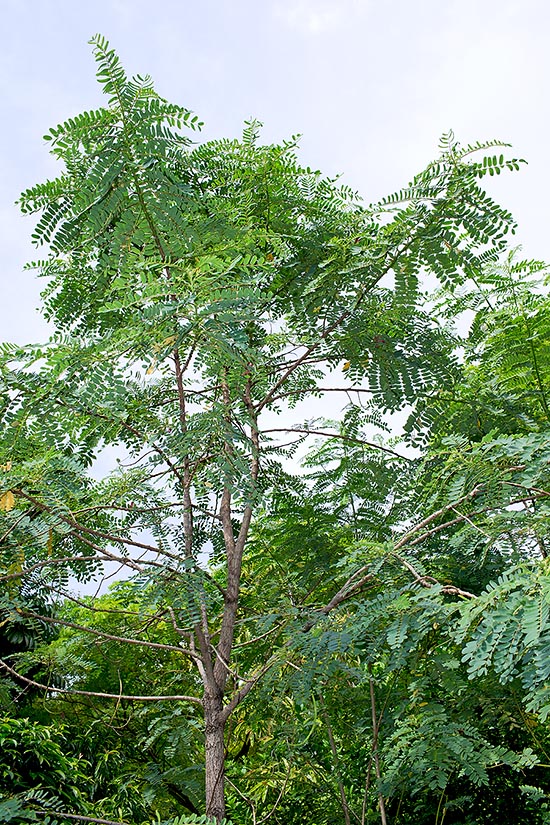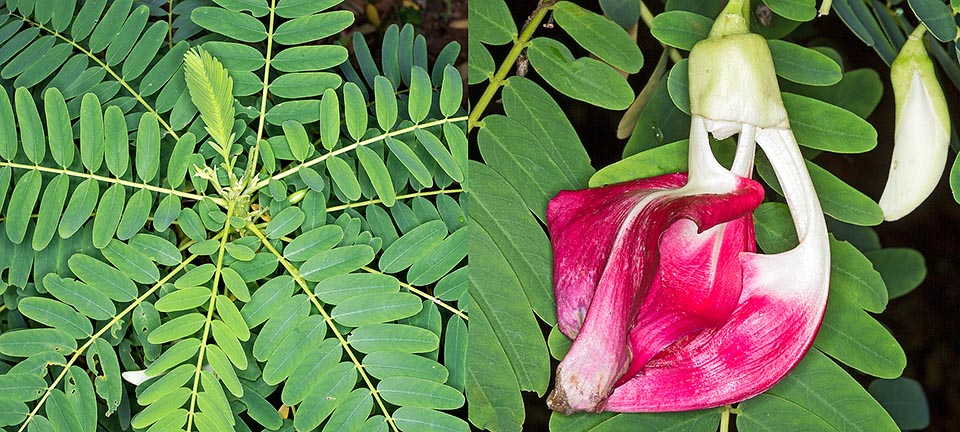Family : Fabaceae

Text © Pietro Puccio

English translation by Mario Beltramini

Amply cultivated in the tropics, Sesbania grandiflora grows fastly up to 12 m © Giuseppe Mazza
The name of the genus comes from the Arabic name “saisabān” of a species belonging to the genus (Sesbania sesban (L.) Merr., 1912); the specific name is the combination of the Latin adjective “grandis, e” = great and of the substantive “flos, -oris” = flower, with obvious reference.
Common names: agati sesbania, corkwood tree, hummingbird tree, scarlet wistaria-tree, vegetable-hummingbird, West Indian-pea (English); agati, bak (Bengali); da hua tian jing (Chinese); colibri végétal, fagotier, fleur papillon, pois valier (French); shiro gocho (Japanese); agasti, agasati, basna, hatiya (Hindi); kembang turi, toroy, tuwi (Indonesian); agasti (Nepali); agasto, sesbania (Portuguese); agasti, agati, varnari (Sanskrit); báculo, cresta de gallo, gallito, pico de flamenco, sesbania agata (Spanish); agathi, agatti (Tamil); khae baan, khae daeng (Thai); so đũa (Vietnamese).
The Sesbania grandiflora (L.) Pers. (1807) is a small evergreen tree, tall up to 12 m with erect cylindrical trunk, of 10-30 cm of diameter, with greyish bark, fissured, from whose wounds exudes a reddish resin utilizable in lieu of the Arabic gum; the rooting apparatus is capable to fix the atmospheric nitrogen thus enriching of it the soil in a considerable way.
The leaves are paripinnate, alternate, 15-35 cm long, with 10-30 couples of opposite or sub-opposite oblong leaflets with obtuse apex, 1,8-4 cm long and 0,6-1,5 cm broad.
Hanging racemose inflorescences at the axil of the leaves, 4-7 cm long, bearing 2-4 papilionaceous flowers on a 1-2 cm long pubescent pedicle. Green campanulate calyx, 1,8-2,5 cm long, pink, red or white corolla with ovate-oblong vexillum, 5-10 cm long and 3-6 cm broad, ovate falcate wings, 5-10 cm long and 2-3 cm broad, 5-8 cm long and 3-4,5 cm broad keel, and 10 curved stamina, of which 9 with the filaments fused together and one free (diadelphous), of about 10 cm of length. The fruit is a slightly curved linear dehiscent legume, 30-60 cm long and 0,8 cm broad, containing 20-40 elliptic seeds, compressed, of about 0,6 cm of length and 0,4 cm of breadth, of brown colour.
It easily reproduces by seed, which does not need particular pretreatments, in draining loam maintained humid at the temperature of 24-26 °C, with germination times of 10-20 days and first blooming within one year; it propagates also by air cutting and air layering.
Species of particularly fast growth, being able to reach in the first year, with good availability of water, a height of 4-5 m, but short-lived, cultivable exclusively in the tropical and humid subtropical zones, not bearing temperature drops close to 0 °C and long periods with values around the 10 °C. It requires a full sun exposition, even if it bears a slight shade, and is not particular about the soil, even poor and slightly salty, acidic or alkaline. It does tolerate the water stagnations and the periodical floodings, developping in this case adventitious and pneumatophorous roots (roots emerging from the water or the mud allowing the oxygen supply to the submerged organs).

It accepts any soil, even swampy. The young cooked leaves are edible, rich of proteins, vitamins and minerals. Fleshy flowers for soups and salads. Medicinal virtues © Giuseppe Mazza
Thanks to its versatility, it has diffused in various tropical and subtropical countries where is cultivated mainly due to its ornamental characteristics, as isolated specimen or as road tree, and for the leaves, rich of proteins, vitamins and minerals, utilized in human food, as fodder for ruminants and in the green manure, for this purpose it is often planted at the edges of the rice fields. It is also employed to form wind barriers in the plantations of coffee, citrus and banana, as support for the plants of pepper (Piper nigrum L.) and of betel (Piper betle L.), and in the reforestation; the wood, light, is utilized in the paper industry and locally as fuel.
In addition to the young leaves, cooked and added in various dishes typical of the south-eastern cuisine, are consumed also the flowers, preferably the white-coloured ones, deprived of the bitter tasting stamens, raw or steamed and added to soups and salads. All parts of the plant are utilized since remote in the traditional medicine for an broad spectrum of pathologies.
Synonyms: Robinia grandiflora L. (1753); Aeschynomene grandiflora (L.) L (1763); Dolichos arboreus Forssk. (1775); Aeschynomene coccinea L. f. (1781); Coronilla coccinea (L. f.) Willd. (1802); Coronilla grandiflora (L.) Willd. (1802); Sesban coccinea (L. f.) Poir. (1806); Sesban grandiflorus (L.) Poir. (1806); Sesbania coccinea (L. f.) Pers. (1807); Agati coccinea (L. f.) Desv. (1813); Agati grandiflora (L.) Desv. (1813); Dolichos arborescens G. Don (1832); Agati grandiflora var. coccinea (L. f.) Wight & Arn. (1834); Resupinaria grandiflora (L.) Raf. (1838); Emerus grandiflorus (L.) Kuntze (1891).
→ To appreciate the biodiversity within the family of FABACEAE please click here.
